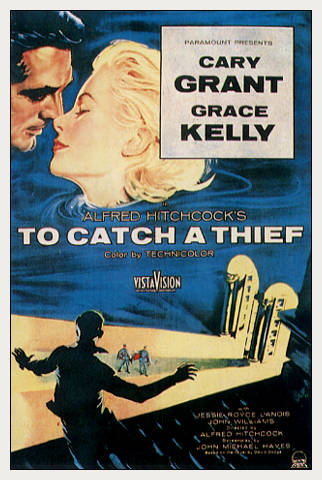
|
To Catch a Thief
Writers:
David Dodge (novel), John Michael Hayes
Composer:
Lyn Murray
Director of Photography:
Robert Burks
Cast:
| Brigitte Auber |
Danielle |
| Rene Blancard |
Lepic |
| Guy De Vestel |
Detective |
| Russell Gaige |
Mr. Sanford |
| Cary Grant |
John Robie |
| Jean Hebey |
Mercier |
| Grace Kelly |
Frances Stevens |
| Bela Kovacs |
Detective |
| John (I) Williams |
H. H. Hughson |
|
Hitchcock's brilliant Rear Window -- intense, claustrophobic, and obsessive -- was followed by "a lightweight story," as he called it. From the facsimile of a crowded New York block and work on a studio-bound picture, he traveled to the bright openness of the French Riviera. For his second project with writer John Michael Hayes, they turned David Dodge's novel To Catch a Thief into a rambling, relaxed, comic caper. Robert Burks won an Academy Award for his luminous color cinematography for it, and Grace Kelly was gently poised between stylish elegance and a kind of cool, poignant isolation. The picture is ravishingly pretty, intermittently funny, surprising (for 1955) in its risquè dialogue, and in the final analysis a sweetish confection, the relaxed work of a man on holiday. This is not to damn with faint praise; it is merely to indicate that the picture should perhaps not be taken with very much gravity.
To Catch a Thief concerns John Robie, a former jewel thief and collaborator with the Resistance during the Nazi occupation of France. The police suspect he's returned to his former job and is responsible for a series of burglaries among the Riviera's rich. To prove his innocnce, Robie embarks on his own investigation to catch the thief. He engages the help of an insurance agent named Hughson, and soon meets the rich young American Frances Stevens, called Francie, and her mother. Francie is fascinated by the man's reputation as a thief, falls in love with him and, although she at first believes him guilty, finally help him catch the real cat burglar.
The film's title, drawn from the famous proverb, is of course double-edged. Robie is indeed a former thief who must catch a thief. But Francie also tries to catch Robie -- first when she thinks he's the villain (and this excites her somewhat more than it should), then as a husband. Her sexual desire is in fact indistinguishable from her fascination for his criminal record. ("I've never caught a real thief before. This is quite stimulating!")
The picture has considerable charm and the performances are unerringly right. To Catch a Thief is in the genre of The Lady Vanishes -- a creampuff of what is sometimes called a movie-movie, with just a little suspense at the end. Here, it's Danielle's last-minute clinging to the rooftop. The film is a comedy, and she's saved, of course -- ultimately luckier than Saboteur's Fry or North By Northwest's Leonard and Valerian or poor Judy Barton in Vertigo -- because Danielle is ... well, only a thief, after all...
Back to Pete's Pad |
Movies |
Hitchcock
Text copyright © Donald Spoto, The Art of Hitchcock, 1974.
